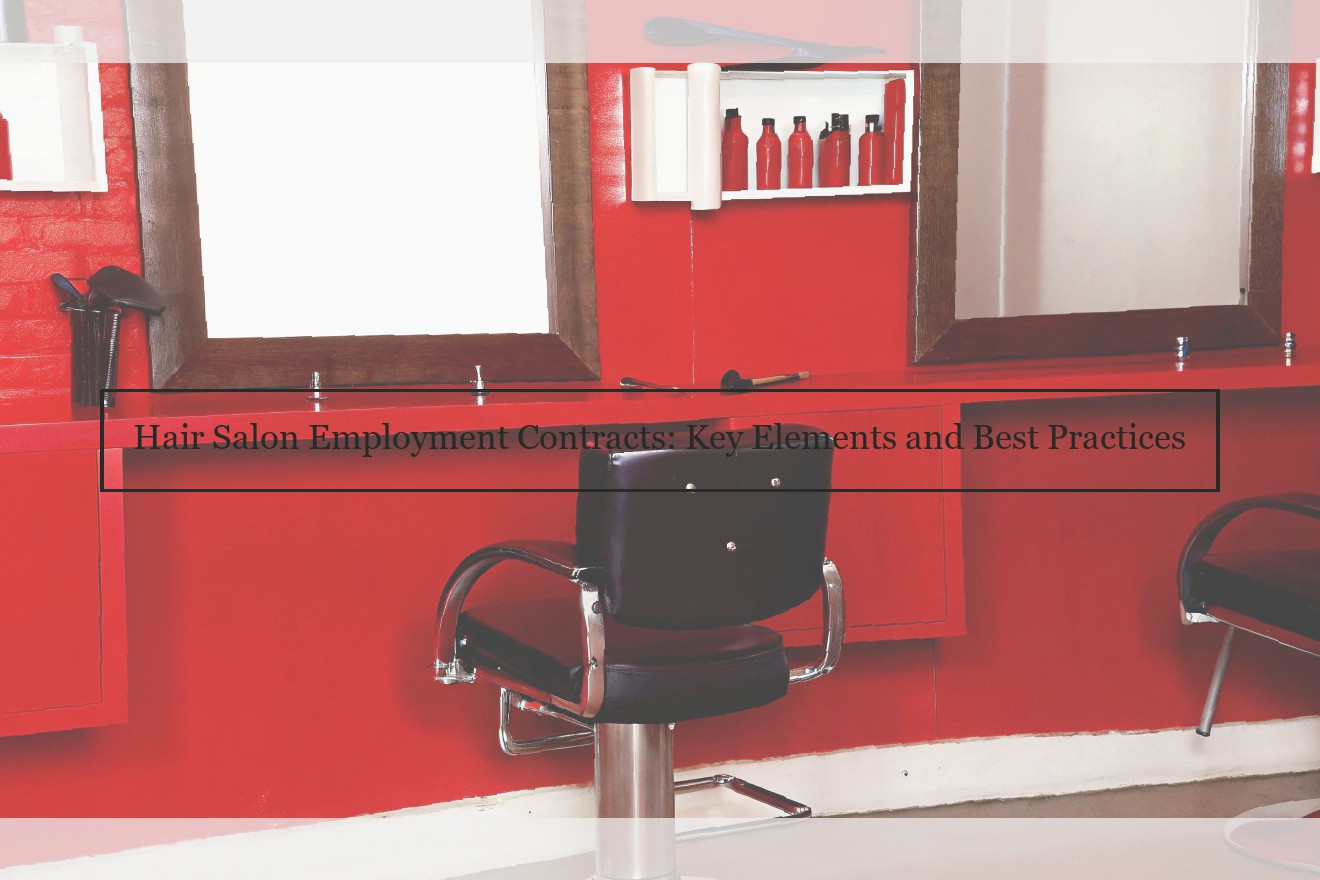Introduction to Employment Agreements for Hair Salon Professionals
By entering into a hair salon employment agreement that clearly outlines the responsibilities of the employer and the employee, a number of issues can be avoided as long as both parties comply with the terms of the agreement.
For the salon owner, these agreements ensure that all employees understand the extent of their duties, responsibilities and entitlements. If a dispute should arise and have to be decided by a third party, a well written contract will be a significant factor to be weighed in the decision-making process.
For the employee, the agreement offers protection for entitlements such as wages and superannuation, hours of work and, in some cases , long service leave. The foundation document may also protect the stylist’s and salon owner’s reputation in regard to client confidentiality and non-competition.
Typical elements of a hairdressing salon employment agreement include:
Duties and Responsibilities
Hours of Work
Termination
Tool Ownership and Involvement in General Salon Duties
Remuneration and Annual Leave
Highly experienced hairdressers should take advice about any negotiation strategy and contract language because it is possible that a contract could lead to some rights that are but not in accordance with what either party considers to be the case.
Finally, it is relatively common for hairdressing salon owners to enter into an agreement whereby a stylist has a probationary period. Often the length of the probation is six months, although it can sometimes be shorter. Sometimes the probation will not even be mentioned in the agreement. Whether or not a probationary period is set out in writing is not an issue as a matter of law, but for the purposes of clarity it’s usually best to do so.
Key Clauses in Employment Agreements
The following key clauses assure compliance with common law, industry standards and consumer expectations to well define the relationship between a hair salon and its employees, as well as protect that salon from exposure to civil actions and damage awards:
- Job Duties. The employment agreement should include a description of the employee’s responsibilities, such as providing hair and skin care services, technical and administrative tasks and marketing promotions and products. The description should also highlight the fact that the employee is technically proficient in the art of hair styling and understands that their duties will be professional and cosmetically correct.
- Compensation. The compensation clause is the linchpin of the agreement as it specifies how and when the employee will be paid (e.g., hourly or commission based), establishes how new services and products will be introduced into their menu of services, and demands that the employee comply with the Hairdresser Law and Board Rules (N.J.A.C. 13:28-2.1). It also includes a requirement for the employee to maintain their license, and regularly hold valid certification from the Occupational Safety and Health Administration (OSHA) and the Misuse of Toxic Substances and Hazardous Substance Act (TRSA).
- Confidentiality. The confidentiality clause, which is standard in most employment agreements, prohibits an employee from disclosing sensitive corporate information about the salon or their clients for two (2) years after termination. A 2-year period is generally accepted in the industry but it may be prudent to obtain legal advice before expanding this period.
- Termination Under the Employment Agreement. This clause lists the reasons under which either party may terminate the employment agreement. Common reasons for termination include: job abandonment, inability to perform the agreed-upon duties (due to illness, injury or inability to obtain/maintain a valid license); falsification of employment information; use or abuse of drugs, alcohol and/or tobacco; conviction of a felony; insubordination, disloyalty and/or dishonesty; failure to comply with the salon’s written manual; behavioral issues; and non-performance.
- Governing Law. Each state has laws regulating the salon industry. It is vital that the agreement specifies the governing law at the outset as it will help determine how the agreement is interpreted, issues arising from the employment contract and choice of forum, assuming they have been mutually agreed upon.
Statutory Requirements and Employee Entitlements
Employment agreements in hair salons must adhere to various state and federal labor laws. The agreement should comply with minimum wage and overtime laws, particularly for non-exempt employees subject to the Fair Labor Standards Act (FLSA). Each employment agreement should detail compensation, when and by what means it is to be payed, and any potential deductions.
Employee rights are another important factor. Hair salons must provide employees access to their personnel files, know the average number of hours employees work weekly, and keep accurate and visible records of employee time. Barring an enforceable non-compete clause in the employment contract, employees have the right to take their clients should they leave the salon and start a salon or spa of their own. They also have the right to leave the salon and be able to take their own clients with them to another salon, if they wish.
Non-compliance with FLSA laws can be costly. Non-exempt employees must be provided breaks and lunch periods that comply with state laws. Failure to provide the minimum number of break times can lead to steep fines and even lawsuits.
Restrictive Trade Practices and Confidentiality in Agreements
Amending or terminating a hair salon employment contract can be a sensitive subject for hairdressers, hair stylists and other salon employees. This sensitivity is compounded when the hairdresser, hair stylist, or salon employee has worked at the beauty salon for a significant period of time. Non-compete and confidentiality clauses may be viewed as disfavorably as the ending of a relationship with a spouse or a significant other.
In addition to controlling the behavior of hairdressers, hair stylists, or salon employees after their employment ends, non-compete and confidentiality clauses can be critical to protecting the business interests of the beauty salon. Disabling this protection for a salon will limit the ability of the salon to protect its interests from its former employees. On the other hand, tightening the restrictions contained in an employment agreement can be seen by the hairdresser as a significant abridgement of personal freedom with respect to future employment opportunities.
Restrictive covenants such as non-compete and confidentiality provisions are commonly used to prevent a shareholder, director, or officer from competing with the corporation or making known or transmitting any confidential information of the corporation after their employment ends. These provisions are included to protect the corporation’s business, including customer lists, client histories, technique and product information, trade secrets, and the confidentiality that is essential in providing for the stylist’s reputation. The trade secrets and confidential information that a beauty salon provides to a hairdresser or hair stylist with respect to its customers must be protected. For example, hairdressers frequently have access to the phone numbers or email address of the salon’s customers, and these access points provide the former stylist with a way to contact the salon’s customers while gaining their trust through personal friendships. A targeted non-compete categorically preventing this solicitation of customers, blocks the salon’s former employees from utilizing confidential information gained during their employment with the salon. Preserving this secrecy of contacts is vital, because contact information for the salon’s customers are a natural target for competition therefrom.
Employers must decide whether to draft narrow or broad non-compete and confidentiality clauses. A narrowly drafted restrictive covenant with the hairdresser will generally allow the hairdresser to legitimately pursue employment in the same field. Yet the vulnerability of the salon provides little protection. In contrast, a broadly drafted non-compete clause that prevents the hairdresser from opening up a competing business down the street will significantly curtail future professional opportunities but will offer the salon significantly greater protection when and if there is a departure.
The reality is that a stylist’s relationships with her clients, her knowledge of the best techniques and products to use, the stylists’ knowledge of how the salon generates customer loyalty and effective marketing tools, all are central to the business of the salon.
Negotiating Over Employment Agreements for Hair Salon Staff
Negotiating the terms and conditions of a Hair Salon Employment Agreement can be an arduous task. Whether you are the salon owner or the employee, however, you should approach the process with an open mind and a willingness to give and take. Salons must understand that employees are generally the driving force of a company, and are paid on the premise of providing them with opportunities to grow and work in an environment that they enjoy being a part of. Without employees, salons cannot continue to grow and make more money. For this reason, both parties should approach the negotiation process with a willingness to be flexible and creative in their requests. Parties should value the importance of their relationship, keeping the lines of communication open and being as upfront and transparent as possible during negotiations. Parties should take the time to speak with other salons and employees in the industry and make themselves aware of the industry standards and the changes that are occurring. Salons should ask employees in order to gauge their level of satisfaction with their current working environment as well as how much more they are willing to pay for benefits currently provided by their employer. Once the salon considers this information, an official proposal can be made to the potential hire who will be in a much greater position to gauge the level of value that will come from the increased expense/investment. Employees should be willing to have a discussion with the salon owner in order to understand their reason for requesting a raise or increased compensation . Employees should also ask whether their request can be satisfied through other means. For example, does the employee feel more valued by receiving extra time off? Does the employee feel more valued by a bonus system? Have they had a chance to consider other ways to provide value to their employer? In some cases, employees may learn that although they are paid a lower base salary, they are making more than they understand due to high-volume of customers and tips received. In this scenario, it may be more beneficial for the employee to remain in front of the client and perform their duties. The employee and owner can continue to further discuss this topic, and if allowed, they can solicit the opinions of higher paying salons and or other employees to verify this information. Salons and employees that go through a flexible negotiation process will both come away from the process having their needs met (within reason). This will be beneficial to both the employee and the salon. After employment starts and the relationship is more intimate, negotiating for additional vacation days or a raise will be easier. If the employee leaves the salon and a new potential hire enters, that new hire will likely not be interested in negotiating additional compensation if they know that their predecessor was unhappy with their agreement, despite the length of service and their years of experience. When the negotiation process is collaborative, employees and owners are more likely to come away from the process happy and wanting to return to the negotiation table in the future.
Preventing and Disputes Between Hair Salon Employers and Employees
Disagreements over wages are the most likely area to give rise to a dispute between the salon employer and employee. This is especially so if the union objected to employees receiving tips. It is therefore important to clarify with workers earning tips the amount of their base pay in a way that makes clear to the worker that a portion of the worker’s pay is being provided in tips. In hair salons this can be done simply by indicating at the start of the agreement that the worker will receive a certain amount each hour plus tips.
Some other common disputes between hair salon owners and stylists relate to scope of work (e.g., the stylist wants to do nails but the owner has limited his responsibilities to hairstyling) and non-competes. A stylist who has been sued for violation of a non-compete is likely to argue that the restrictions in the non-compete are unreasonable. That argument is sometimes paired with an assertion that the owner has taken money out of the business and is therefore not entitled to relief from the employee.
Any dispute that arises under an agreement should always be brought to us immediately. Even a small violation can snowball into a significant problem that costs the business substantial amounts of money and time. At the same time, it is essential that you understand your rights and responsibilities under the agreement to avoid disputes before they arise.
Review and Update of Hair Salon Employment Agreements
All hair salon employment agreements should be reviewed and revised periodically to reflect changes in the law, regulations and, importantly, the employers’ own policies and practices. For instance, a salon employer may want to amend an employment agreement to provide stronger non-compete protections in the wake of a new competitor moving into the area or to provide for its guests’ electronic payment for tips to hair stylists and technicians. A stylist who is performing new services may be a candidate for a new employment agreement. Or, the stylist may be entitled to overtime and therefore require a new exempt status designation. Conducting regular audits of employment agreements will ensure that they contain up-to-date provisions consistent with current laws and regulations and also with company policies.
Conclusion: Employment Agreements Techniques
The big takeaway from the above on all of this are that hair salon employment agreements are essential in protecting both the salon owner and the hairstylist. They provide a firm legal basis for the employment relationship and therefore help to avoid the kind of disputes that can otherwise arise. However, there is a need to draft these agreements carefully to ensure that they are fair and reflect the true requirements of the business.
In other words , it pays to take a proactive and cooperative approach to this process. Sitting down with your hairstylists as a group to discuss the requirements of your business, any disputes you have already had with them over policies and how you want things to work going forward, hopefully at least a few of those stylist will appreciate that you are doing this to avoid problems the future and you will be able to persuade these people to sign a more comprehensive agreement to your advantage.




+ There are no comments
Add yours